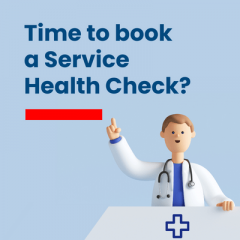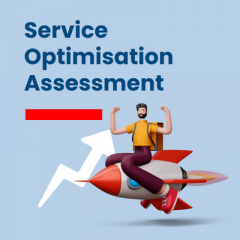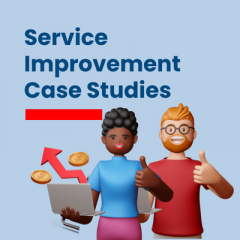
While it may not seem like it on the surface, HR, facilities and IT have a lot in common. In fact, any internal corporate service provider dealing with similar types of requests – for help, information, services, and changes to existing services – has a lot in common with IT.
So, it’s no big surprise that using IT Service Management (ITSM) best practices in other corporate departments to improve performance – something the ITSM world calls Enterprise Service Management (ESM) – is emerging as something HR, facilities and other internal service teams might find interesting.
Giving employees the best of all worlds
What if your company’s employees could easily get answers to all their IT, Facilities, HR and other service questions in one place? Without having to search for the right channel or person?
Today it’s vital to enable your [possibly siloed] corporate service teams to join forces and process requests through a single point of contact. By streamlining support across your business, you’ll solve problems faster, communicate better, and offer more value to your employees.
Collaboration is at the core of ESM. Basically, Enterprise Service Management means different service departments working together. Usually, this involves using a common tool for processing calls and a single point of (first) contact for customers. Sometimes it goes much further, with a full-blown ESM approach meaning that all service departments are integrated.
What are the benefits of uniting corporate services?
Happier customers
With one go-to service point, it’s a no-brainer where employees can go for help. This not only increases transparency, it’ll make your employees’ experience skyrocket.
Easier collaboration
Bringing your service teams together boosts communication, making it easier to share tasks, workflows, best practices and knowledge – and ultimately help colleagues be more productive.
Higher ROI and lower costs
Sharing the workload means operational costs go down. And you’ll also spare the expense of department-specific tools.
Higher quality of services
Using the strengths of each department means you’ll solve problems faster, leaving more time for larger improvements like knowledge-centered service.
One hub at the centre of your service delivery
Imagine this: an employee has to give a presentation in half an hour when they find out the screen in the meeting room isn’t working. Luckily, there are multiple phone numbers they can call. But your employees never really know who’s going to answer the phone, or which number they have to call to fix which problem. Instead, they end up in a black hole. Houston, we have a problem!
Another scenario. Say you’ve got a new employee coming into work. HR needs to set up payroll and benefits. Facilities provides a desk and chair and IT sets up a new PC. Onboarding is a joint effort for service departments. But how can you keep track of progress across the boards?

You can more easily assign and share calls, gain insight into joint projects, and leverage knowledge – both between your service teams, and with external parties like suppliers if every supporting department has a joint point of contact. Your customers don’t have to wonder who to turn to with a question and processing every incoming request – whether it’s for HR, facilities or legal – in the same tool means better cross-departmental collaboration and smoother customer interactions. It’s easy to set up automated workflows too.
Small steps really can be giant leaps
Let’s be realistic. Enterprise Service Management sounds great, but you can’t just merge a bunch of departments tomorrow and expect everybody to be on board and ready for take-off. The reality is, different departments have different ways of working. Calls go through different processes, and even terms like ‘incident’ don’t mean the same in IT and, for instance, facilities. And if you tell HR that there’s been an incident, they might get really worried. So if you don’t even speak the same language, how will you work together on calls and projects?
Well, here’s the thing: ESM is often seen as a complete package. A single goal to work towards: happier customers through total collaboration. But who says you have to stick to this all or nothing approach? What if each small step could make a big difference? You don’t need to do a complete overhaul of your department to get started. You can get excellent results with a few small changes.
Why not start simple and get together. Find out who’s who and start to discuss how you work. How do the different departments perceive each other? What problems do you run into when you have to communicate? One example is how can you improve collaboration for a specific process, like getting a new employee up and running? Come up with solutions for the problems you run into. Make a plan, stick to it, and get together again after some time to see if your collaboration is improving.
One small step towards shared services
As we’ve seen [Enterprise] Service Management is much more than just departments sharing tools. Service management means collaborating on how services are delivered and if your organisation is ready to bring your corporate services together, you’ll find you can:
- Start applying best practices from each team
- Set cross-departmental common goals
- Create reports that cover the goals of multiple teams
- Manage expectations and enforce SLAs
- Give your employees a better experience with your processes aligned
- Simplify the customer/employee journey resulting in lower costs and increased efficiency
- Free up valuable resources to invest in other areas of the business, like innovation
A very compelling argument for some leaders is simplifying the employee service experience with ESM to achieve cost reduction, and this can be achieved. If a customer has no clue where to make a request, they might need half an hour to ask their question to begin with. With a joint point of contact, it might only take them five minutes, which leaves 25 minutes for them to focus on the things they do best.
It makes complete sense to have a place for employees to turn to with questions and requests, especially when they need help fast. This means a broken screen is fixed in no time so your employee can go ahead with their presentation. New employee starting? All the service departments know what to do and when, giving the new employee a great experience on their first day.
So if your organisation is focusing on improving employee experience – a big priority for many companies transitioning to hybrid or home working – maybe the place to start is by talking to IT? After all they’ve been perfecting the art of happy employees through brilliant customer service for decades.
For more practical support on where to start with ESM, why not speak to the learned folks at Topdesk or Freshworks?
COMING SOON!
SDI is planning a virtual event on 30 November where we’ll be looking at Next Generation Workplaces: The Future of Service Management; from where to start and how to speed up your shared services journey to help your employees work better and be more productive. Aimed at non-IT service leaders and IT service professionals alike, register for free today and we will keep you updated as the programme develops. We have some very exciting speakers planned for you!
























